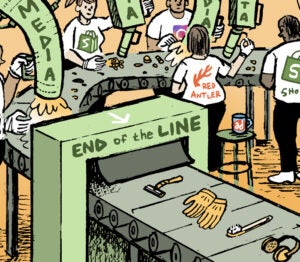 At 1.55 billion monthly active users and growing, Facebook’s audience reach is massive. And Facebook is hammering out constant improvements to the video discovery mechanism in the news feed.
At 1.55 billion monthly active users and growing, Facebook’s audience reach is massive. And Facebook is hammering out constant improvements to the video discovery mechanism in the news feed.
But the social platform remains largely in experimental mode with video, and agencies and publishers are chomping at the bit for a clearer monetization path and more measurement opportunities.
About a year ago, Facebook released a video player that allowed publishers to embed Facebook-hosted video on their sites and increase discoverability across the web.
Three months ago, it launched a recommendation product called Suggested Videos, which also contained beta versions of in-line video ads for partners like Fox Sports, the NBA and Funny or Die, who would get 55% of ad revenue.
“We found early on that view counts and engagement [were] very encouraging,” said Pete Vlastelica, EVP of digital for Fox Sports. “It made sense for us to dedicate resources and investment to Facebook specifically and start to really learn what worked best on Facebook.”
Often, what worked best on YouTube or on Fox Sports’ own player didn’t translate to Facebook, which required some adjustment on formats pretty early on in the rollout.
Kind Of Like ‘Channel Surfing’
“Testing” with video has been the name of the game for publishers, advertisers and Facebook itself for the greater part of a year.
While YouTube is more search-based and consumers visit the video destination site with clear intent to watch a video, the Facebook use case is much more diversified. You’re checking the feed for friends’ updates or sharing photos, and if you watch a video it’s usually more serendipitous.
Fox, for instance, wouldn’t publish sports news updates throughout the day to YouTube unless the clips had evergreen appeal. Facebook, however, has that air of real-time recency.
“It’s kind of the new channel surfing,” Vlastelica said. “The opportunity you have on Facebook is to capture the user’s attention in the first three to five seconds of a video, under conditions we never saw before – autoplay with the sound off.”
AdExchanger Daily
Get our editors’ roundup delivered to your inbox every weekday.
Daily Roundup
Fox Sports found using bold title cards and striking visual content captured user attention as they scrolled, often never expanding the video to full screen in the feed.
For lifestyle platform PopSugar, Facebook video also presents a compelling, but unique, nut to crack. PopSugar Studios President David Grant, the guy who’s responsible for driving video growth for the publisher, noted it’s banking 90 million-plus total video views per month, more than half of which come from Facebook.
Because PopSugar creates all of its own original video, shows like “We Spy Style” and “Get The Dish” often have TV production value.
“On PopSugar.com, the information is as important as the speaker, whereas on YouTube, I’d argue the speaker is probably more important than the information,” Grant said.
While an 18-minute talk show translated well to YouTube, Facebook fans weren’t having it.
“You cannot do an 18-minute talk show effectively on Facebook,” Grant added. “We’re constantly looking at new data figuring out what made somebody watch after three seconds.”
Grant noted there’s no one size fits all, but generally, consumers must be gripped within three seconds or the publisher risks users dropping off. And keeping viewers for 30 seconds is gold, since there are a multitude of things competing for consumer attention in the news feed.
Creating New Currency
One of the toughest things for Facebook video partners is measuring across platforms, which isn’t black and white because different platforms – surprise! – have different definitions of a video view. And those definitions can change.
A viewed YouTube video is generally 30 seconds. Three seconds was the norm on Facebook, but advertiser demand shifted that to 10 seconds.
“What Facebook will need to do is give publishers and marketers better means to measure the success of video content – whether branded or not,” Vlastelica said. “It’s not the case that for a longer-form piece of content; a view on Facebook is equivalent to a view on television or even YouTube. You just don’t have enough information to deduce that.”
In other words, a 10-second view might be a start, but it’s still too broad a metric. Marketers will remain cynical about Facebook video until the platform gets more granular.
“I’d really like to see Facebook – and Twitter, for that matter – start to report on watch time so we can start to measure minutes viewed across every platform and treat that as a common currency we can bring to brands,” Vlastelica added. “Even if you don’t know total watch time on a platform like Facebook, I can say viewership there is massive.”
How massive?
Fox Sports has reached a point where it’s getting 250 million –a quarter of a billion – views on Facebook alone. It’s now test driving Facebook’s Live platform to see how it resonates with viewers, tying content from a one-hour show it’s “quadcasting” to four distribution points daily – Periscope, Facebook Live, YouTube and Fox Sports Go.
From UGC To TV Tune-In
Although Facebook generates giant view counts, it’s hard to monetize. And it’s doubtful pre-roll will be the most viable route – a lot of video on Facebook is shared, and to serve pre-roll against that content feels intrusive.
“Facebook has a challenging story to tell because they have a lot of data, but I would argue the Facebook environment is probably the last place you’re going to engage with a video ad,” at least for a meaningful period of time, said Bertrand Quesada, CEO of native video ad platform Teads.
“They’re selling massive impressions to clients,” Quesada said, but he claimed the ability to measure it all has been somewhat of a black box, “which is why they’re beginning to open up to third-party verification companies (like Moat). Because they have to.”
Like the early days of YouTube, some marketers worry Facebook is a “user-generated vat” of video content. And because consumers don’t think of Facebook as a video destination site, it’s difficult to predict how they will respond to branded and/or publisher content – or if they’ll even see it in the first place.
But industry insiders say Facebook is being deliberate. It is testing all aspects of video in the news feed before committing to a clear-cut monetization plan. Through programs like Anthology, which connects marketers with branded video content from publishers, the idea is to facilitate growth of premium video.
“They’re obviously trying a lot of different things, from live video to this immersive, 360-degree experience,” said Sean Corcoran, executive director of innovation at Mullen Lowe agency Mediahub. “They do have a pretty good handle on the long view. There’s this feeling that they need to be a key app within the future TV model along with Netflix, Hulu and YouTube.”
And although Facebook is edging closer to TV-equivalent metrics like TRPs/GRPs, the question is how much premium content will it amass?
Hosting broadcast partner video from the NFL and Fox, for example, is a giant step, but Facebook makes the determination on where that branded video shows up as an ad on the news feed or as a Suggested Video, so publishers still have their hands tied in some respects.
“When we pitch our content on Facebook to brands, our focus is on the fact that this isn’t just Facebook video, this is Fox Sports video on Facebook,” Vlastelica said.
Having that broadcast brand clout makes a “big difference” in an environment where brands view early Facebook video in the way they had other user-generated platforms. As Vlastelica described: “being full of content that’s not necessarily premium.”
PopSugar’s Grant echoed some of those sentiments.
“The big question is striking that balance of keeping the ecosystem a win-win-win, for viewers, publishers/advertisers and Facebook,” he said. “That’s not a foregone conclusion, but remember when Facebook first went public and no one had been able to figure out how to monetize mobile? Guess what? Facebook figured it out in spades.”













